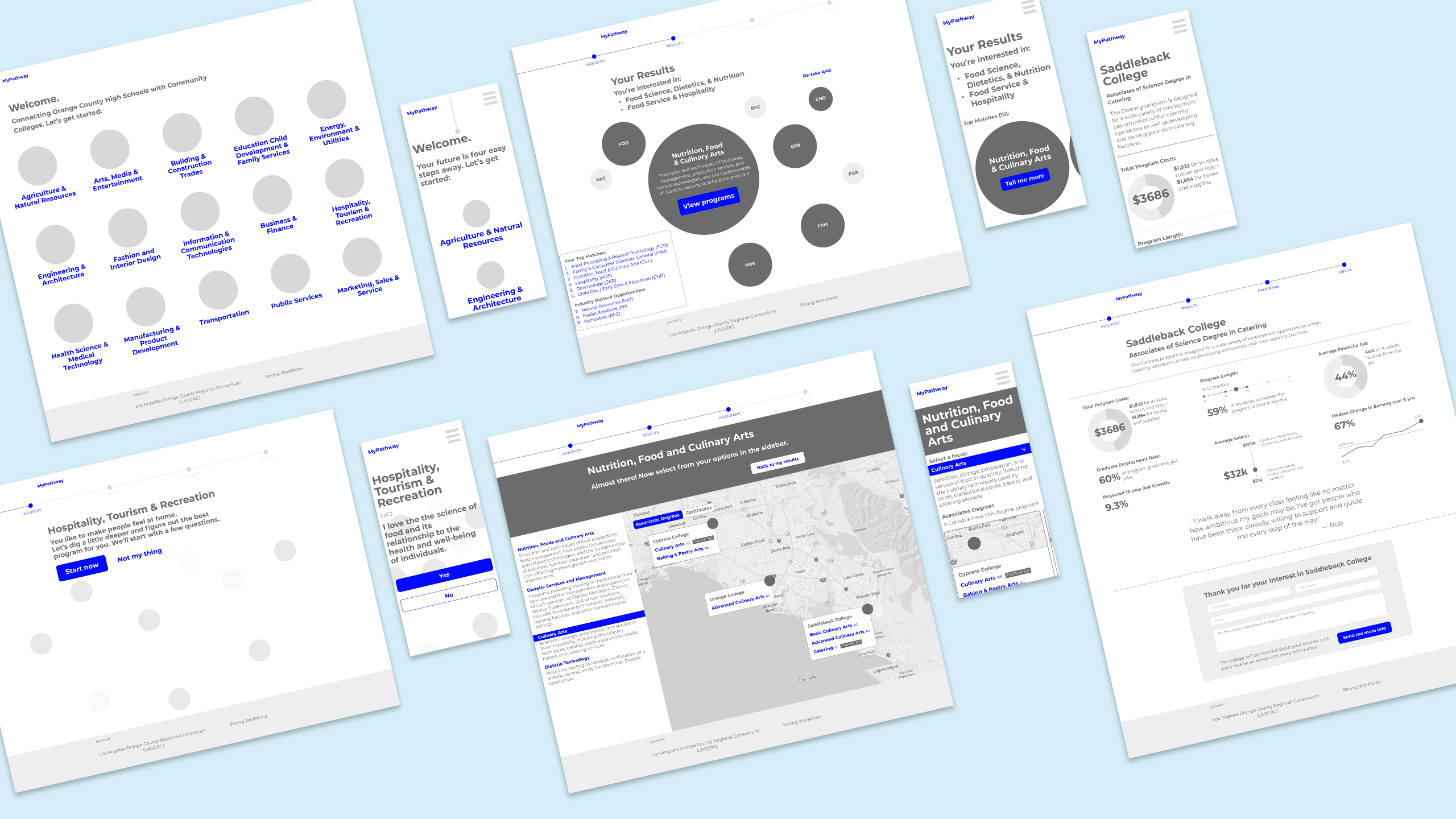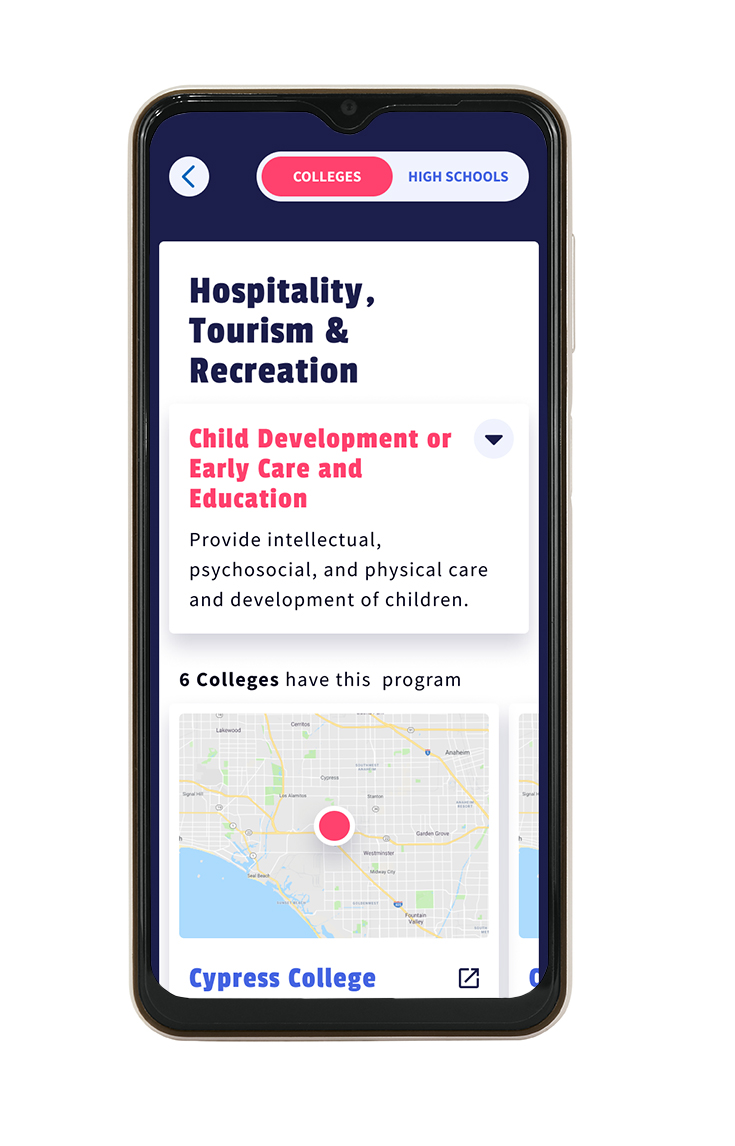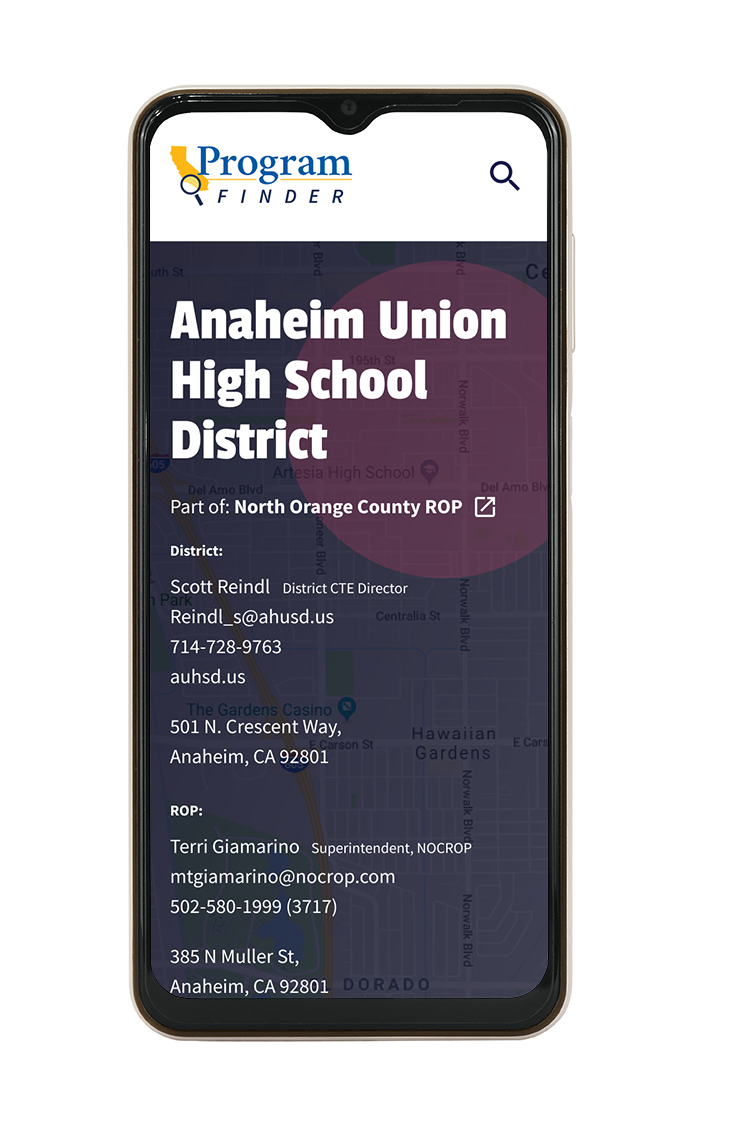Program Finder
A zero-to-one project connecting California high school students to career programs in the largest community college system in the country.

Role: Lead UX Designer
Team: Jordan Anderson (UI Designer), Adam Barton (Creative Director), Joey Bruckner (Project Manager), Bob Cowell (QA and Accessibility) Dave Erwin (Front End Developer), Caitlyn Holland (Lead UX Designer), Nancy Johnson (UX Content Writer), Samantha Kalita (Director of UX), Austin Lally (Software Engineer), Ian Poss (Software Engineer), Megan Smith (Accessibility Specialist)
My Contribution: UX Design
Employer: Concentric Sky
Team: Jordan Anderson (UI Designer), Adam Barton (Creative Director), Joey Bruckner (Project Manager), Bob Cowell (QA and Accessibility) Dave Erwin (Front End Developer), Caitlyn Holland (Lead UX Designer), Nancy Johnson (UX Content Writer), Samantha Kalita (Director of UX), Austin Lally (Software Engineer), Ian Poss (Software Engineer), Megan Smith (Accessibility Specialist)
My Contribution: UX Design
Employer: Concentric Sky
Client: Orange/Los Angeles County Regional Consortia for California Community Colleges
Skills: UX Design, Prototyping, Collaboration, Client Presentation, Copywriting, Accessibility
Tools: Figma, Lucidchart
Timeline: 18 months
Budget: Approx $1M
Skills: UX Design, Prototyping, Collaboration, Client Presentation, Copywriting, Accessibility
Tools: Figma, Lucidchart
Timeline: 18 months
Budget: Approx $1M
Background
What do I want to do when I graduate? is a question that plagues a lot of high school seniors, but especially low income or first generation students who don’t see themselves at an expensive four-year university far from home. What if they could follow their interests to a local community college, then to a bigger university — or even straight to employment?User Problem
The client had created a proof-of-concept connecting high school Career Technical Education (CTE) with Community College Programs, such as dental/medical tech, bio tech, info tech, etc. They proved the mapping could be done, but it existed as a set of interdependent Excel spreadsheets. They needed a web-based system to get in front of students. The client had a tight timeline and limited state grant budget for the initial phase, which would focus on Orange County and LA.Goal
Create a flexible, scalable, public-facing website that connects high school students in CTE pathways with programs offered by local community colleges. The impact of our MVP would be felt in two counties, 27 community colleges and by over one million students. Our progress would be watched closely, and if the MVP was successful, there was significant statewide interest and potential funding from the California Chancellor's office that would unlock additional phases of work. 2
counties
27
community colleges
1,000,000+
students
Process
- Design a public-facing website for students
- Pivot and re-design for students and college program administrators
- Develop and launch MVP
Design a public-facing website for students
Initially, a quiz structure guided a student through the daunting experience of finding the right college. Personality-type questions narrowed their broad general interest down to a specific program and a map displayed the local colleges offering that program. To get students excited about contacting the college and their future career, we displayed data visualizations on employment rate, job growth, and average salary from the Bureau of Labor and Statistics (BLS).

Low-fidelity HD and mobile views of the initial quiz design.

Data visualizations for program costs, program length, average financial aid, employment rate, job growth, salary, and median change in earning.
2. Pivot and re-design for students and college program adminstrators
Halfway through the budget, our client shared our progress with stakeholders. The feedback revealed that community colleges could be an additional revenue source — but we had to change the designs to accommodate a new user. College program admins could use Program Finder as a marketing tool to find HS districts and recruit potential students. The new approach meant that the tool needed to be simple and straightforward for two different audiences: high school students (primary audience), and the community college Program Administrators (secondary audience). With time and funding running out, I worked closely with the UI team to strip our prototype down to the essentials: interest categories, a map displaying both hig school districts and community colleges, and critical contact information.
Revised goals:
- Connect high school students with local community colleges for higher education
- Connect community college admins with local high school districts for marketing and recruitment
3. Develop and launch MVP
I partnered closely with Engineering and QA to ensure that the final phase of work went smoothly. Our accessibility specialist ensured that the site was navigable — and made sense — to screen readers. Due to the pivot, I helped the client prioritize their needs and identified a core list of features and enhancements for Phase 2. Through open communication and regular client contact, we delivered an MVP that the client was thrilled to share with stakeholders and get in front of students.



Results
A few months after Program Finder’s MVP went live, the client returned with the funding to develop the next set of enhancements. Over the next few years, we completed two additional phases of work, building a robust administrative back-end and introducing employer partners that created a workforce pipeline. As of May 2024, the site is still live at programfinder.com, and has expanded to include San Diego-Imperial. It’s actively used by thousands of students and 114 community colleges. It’s a simple concept, but the response has been huge. As one student said in an interview “I wish I had known about this when I was looking for college.”
3
counties
114
community colleges
state-wide
expansion




“The tool was initially designed for only high school students, but as the work progressed, Caitlyn played a key role in expanding its reach to include the community colleges themselves. It was keen insight on her part that initiated this expansion.”
— Steve Glyer, Chair of the Regional Consortia
